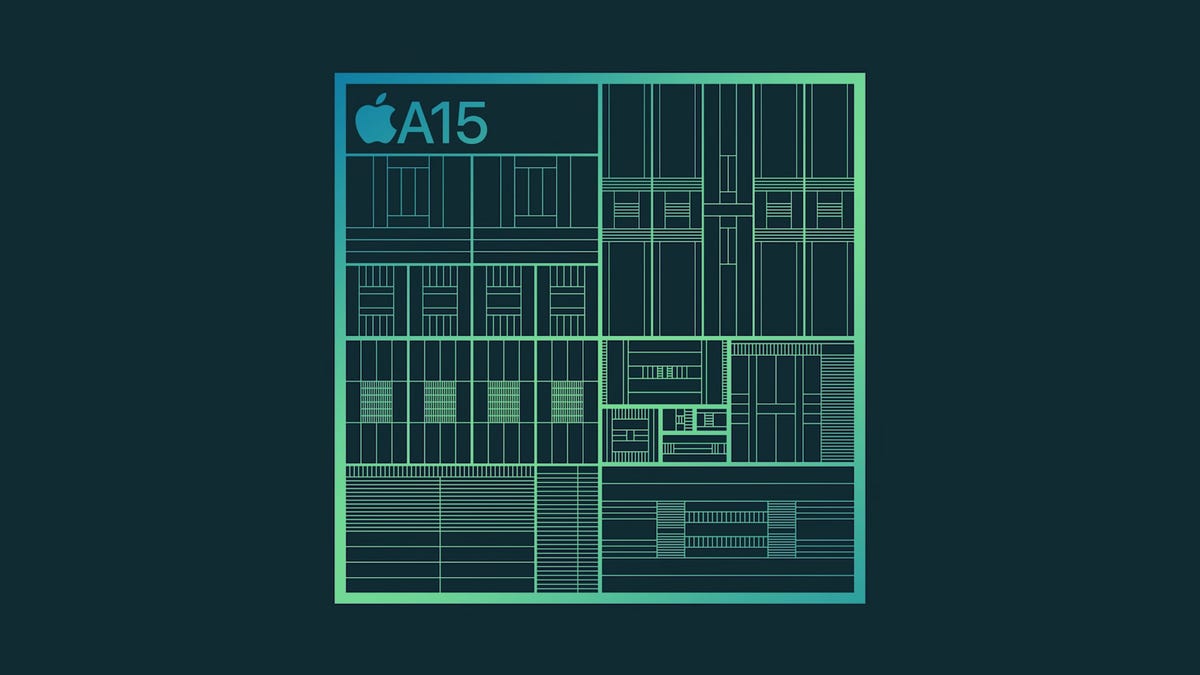Apple's A15 Bionic chip powers iPhone 13 with 15 billion transistors, new graphics and AI
Apple's chip designs have kept its phones faster than the competition for years. This year, iPhone Pro models get more GPU horsepower than regular iPhones.

Apple's A15 processor in the iPhone 13 has 15 billion transistors.
Apple on Tuesday revealed its iPhone 13's processor, the A15 Bionic, a chip with 15 billion transistors and new graphics and AI abilities.
Transistors are the core circuitry elements that process and store data on chips, and the count this year is significantly higher than the 11.8 billion on the A14 chip that powers iPhone 12 models introduced in 2020. Miniaturization lets chip designers pack in more transistors for new abilities, though progress in miniaturization has slowed in recent years.
Like its predecessors, the A15 has two high-performance processing cores for the most important work and four high-efficiency cores for background tasks that can run without sapping as much battery power. But Apple says they're faster and supported by a new graphics processing unit (GPU), higher-performance neural engine for AI and machine learning tasks, and a new image signal processor for chores like reducing photo noise. The company unveiled the chip at its iPhone 13 launch event Tuesday.
Apple boasted the A15 has better performance than its competitors, a claim that's been true for years, based on the Geekbench speed test. However, the company didn't offer details about how much better the A15 is compared with the A14. Qualcomm, the top chipmaker for the Android smartphones, acquired startup Nuvia in an attempt to give its processors a big speed boost.
The chip's top job is to maintain the company's top place for smartphone speed, ensure iPhones remain the first device developers reach for when creating new apps, and keep customers happy with snappy performance and a long useful lifespan for the phone.
The A15 is an important foundation for Apple, not just for the new iPhone. The A15 also will likely power next-generation iPads. And a more powerful variation could be the brains inside new Macs, a follow-up to the way Apple's M1 processor is based on 2020's A14 processor. Apple is amid a two-year process of evicting Intel processors from its Macs.
Designing its own chips gives Apple several advantages. It can set its own priorities in features and release timing. It can better integrate its own software. And more broadly, it can set its own destiny better, a benefit embodied in the "Cook doctrine," named for CEO Tim Cook, to "own and control" the main technologies in its products.
See also
The A15 is built on a 5-nanometer manufacturing process -- the same as the A14. The iPhone 13 and iPhone 13 Mini come with a four-core GPU, but the iPhone Pro and iPhone 13 Pro Max get a five-core GPU.
The new chip has a 16-core "neural engine," circuitry dedicated to speeding up artificial intelligence tasks using today's machine learning technology. That's useful for an increasing breadth of tasks, including generating Siri's synthetic voice, recognizing information in photos, focusing on faces in photos and unlocking your phone with Face ID. Although it's got the same 16 cores as the A14 chip, the 16 increases AI operations from last year's 11 trillion operations per second to 15.8 trillion with the A15, Apple said.
Apple A15 Bionic processor details
Apple relies on Taiwan Semiconductor Manufacturing Co. (TSMC) to build the chips it designs. Apple is usually an early adopter of TSMC's latest manufacturing technology, taking advantage of the gradually shrinking circuitry and improving performance to add new abilities each year. It typically costs more to tap into leading-edge manufacturing capacity, but iPhones are premium products.
Intel has suffered in recent years from delays to new manufacturing processes. The resulting lackluster performance and battery life improvements have made Apple's M1 bet look particularly smart. Intel is trying to get back on track with new manufacturing improvements coming with its Alder Lake PC chips this year and the Meteor Lake successor. But even if Intel's plans bear fruit, it won't be until 2024 that the company catches up to TSMC and 2025 until it reclaims its lead.

